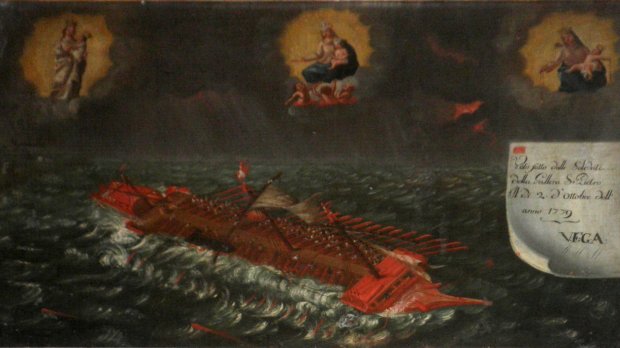The existence of Purgatory is a dogma of our Catholic faith. Purgatory is surely not a pleasant holiday but a terrible temporary punishment that souls must endure to be completely purified. The Catechism of the Catholic Church defines Purgatory as the “final purification of the elect, which is entirely different from the punishment of the damned” (§ 1031).
Souls in Purgatory are saved from eternal damnation; however, they cannot be in God’s Divine presence before being purified.
The Council of Florence (1438-1443) concluded that “if they have died repentant for their sins and having love of God but have not made satisfaction for things they have done or omitted by fruits worthy of penance, then their souls, after death, are cleansed by the punishment of purgatory”; and that “the Sacrifice of the Mass, prayers and almsgiving and other works of piety” are efficacious means of helping these souls getting liberated from purgatory.
In her diary St. Faustina Kowalska wrote:
“… In a moment I was in a misty place full of fire in which there was a great crowd of suffering souls. They were praying fervently, but to no avail, for themselves; only we can come to their aid. The flames, which were burning them, did not touch me at all, I asked these souls what their greatest suffering was. They answered me in one voice that their greatest torment was longing for God.
I saw Our Lady visiting the souls in Purgatory. The souls call Her “The Star of the Sea.” She brings them refreshment …
[I heard an interior voice which said] ‘My mercy does not want this, but justice demands it.’ Since that time, I am in closer communion with the suffering souls.” (Diary, 20)
Pope Paul VI, at the end of the Second Vatican Council, hailed the Blessed Virgin as “Mother of the Church” (Mater Ecclesiae). The church has three components: the Church Triumphant comprised of all the Saints in Heaven, Church Militant composed of all the baptized on earth and the Church Suffering made up of all the Holy Souls in purgatory.
Unfortunately, the latter most often gets the least attention. But it’s a different story when it comes to our Heavenly Mother!
The Blessed Virgin Mary revealed to Saint Bridget of Sweden (c. 1303 – 23 July 1373), “I am the Mother of all the souls in purgatory, and I am Mother of Mercy to these my children who are in the greatest need of my assistance, since in their torments they cannot help themselves.”
Our Lady also revealed that as a compassionate Mother, she condescends to go herself often into that Holy Prison to visit and comfort her suffering children. Indeed, the millennial love the Maltese have for the Blessed Virgin Mary has throughout the centuries served as a heartful remembrance of their departed.
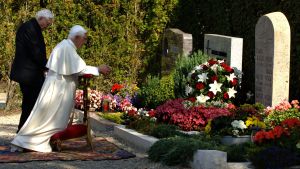
Redeeming the souls in Purgatory in the Maltese Islands
One has only to visit Malta and Gozo and with a keen eye observe the hundreds of street and country niches, church paintings, ex votos, tomb inscriptions, plaques and monuments to come to the conclusion that in Maltese religious tradition, the souls in Purgatory waiting for the moment to be forgiven and proceed to Paradise, was, and still is in the hearts of the living.
Persons, with hands folded in prayer, supplicating the Merciful Lord, His Holy Mother and the Saints, half of the lower part of their bodies in flames, are a constant theme in statutes, cemetery entrances, paintings, streets, niches, hundreds of chapels and churches and open countryside.
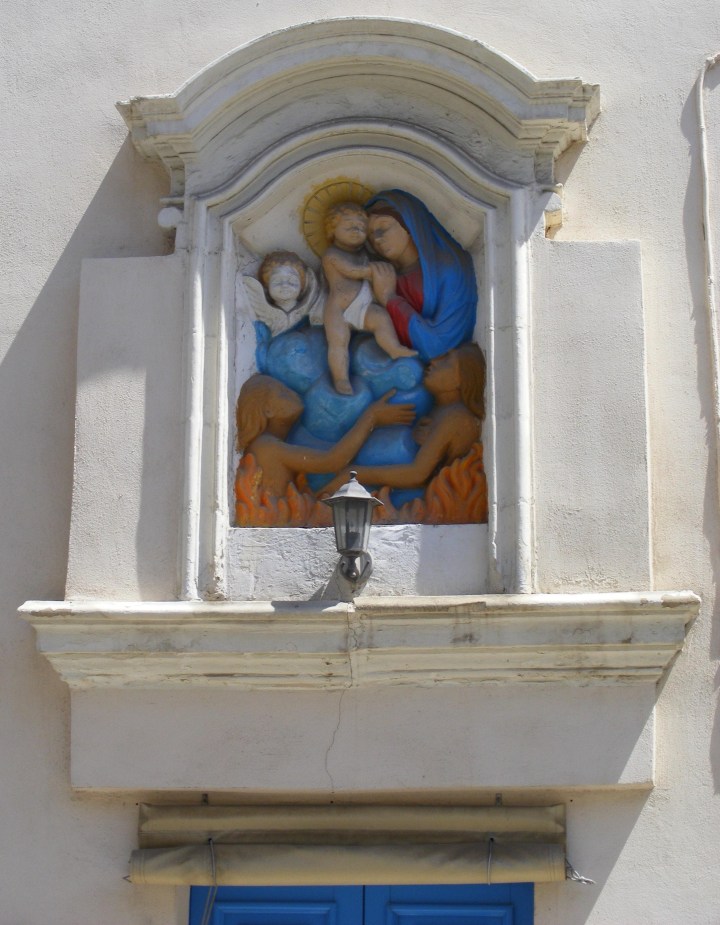
Wikimedia Commons (Photo cropped)
The Marian devotion in which local children are steeped from their earliest years is witnessed by the hundreds of churches and chapels dedicated to the Blessed Virgin (over 200 from a whopping 365 churches in just 316 square kilometers), and we are not far off the mark if we say that even locals who have become lukewarm in their faith still pray to the Mother of God, their Mother.
Centuries of this deep Marian devotion has become bone of the bone and flesh of the flesh of Maltese Catholic beliefs. So, it is only naturally, and instinctively too, that the Maltese trust their Heavenly Mother to take special care and interest in their dead loved ones, ‘to commute’ the long years of purification in Purgatory of their relatives and grant them early pardon for their sins.
One here will do well to notice the special devotion as reflected in the many Carmelite-run parishes and many convents. This fact is associated with Our Lady of Mount Carmel, who is, in many images, represented in her assistance of the Souls in Purgatory. The same can be said of the Dominican Order, which is identified with the Holy Rosary, which in turn is a prayer that is daily recited for the redemption of these suffering souls.
The Maltese have such faith and hope in the Blessed Virgin Mary that as their earthly mothers will give up their lives to save their offspring, so will our Heavenly Mother not leave one stone unturned to help her suffering children burning in the flames of Purgatory.
Maltese idiomatic language, too, shows how entrenched in the country’s psyche is this bond with the Holy Souls. The phrase “Għall-Erwieħ,” which means “For souls in Purgatory,” is instinctively asserted following a good happening – like a deep desire to translate the positive occurrence into an offering for the suffering souls.
Hereunder, are a few examples of related devotions, sites and religious art found across the Maltese Islands.
Our Lady of Mount Carmel, Valletta
The Carmelites first came to Malta in 1418 and they settled in the church of the Annunciation in the countryside, in an area outside Rabat called Lunzjata (derivative of Annunzjata meaning Annunciation). Afterwards, priories were opened all over the Island.
The Carmelites were the first Friars to build a church in the new city of Valletta, in 1586 – today’s Basilica. It’s titular painting depicts Our Lady of Mount Carmel, who gives the scapular to St. Simon Stock and comforts the Holy Souls in Purgatory with her milk, which is expressed from her breasts by Baby Jesus, whom she holds in her arms.
The author of the painting is anonymous. It was probably brought from Sicily, since the Maltese monasteries originally belonged to the Sicilian Province. It was crowned by the Vatican Chapter in 1881, the first painting to be crowned by the Vatican in the Maltese Islands. The painting portrays St. Simon Stock and St. Agatha, one of the patron saints of Malta. There are two other human figures who have been partially removed from the picture. These are an unknown man, on the side of St. Simon, and a female saint, perhaps St. Lucy, beside St. Agatha.
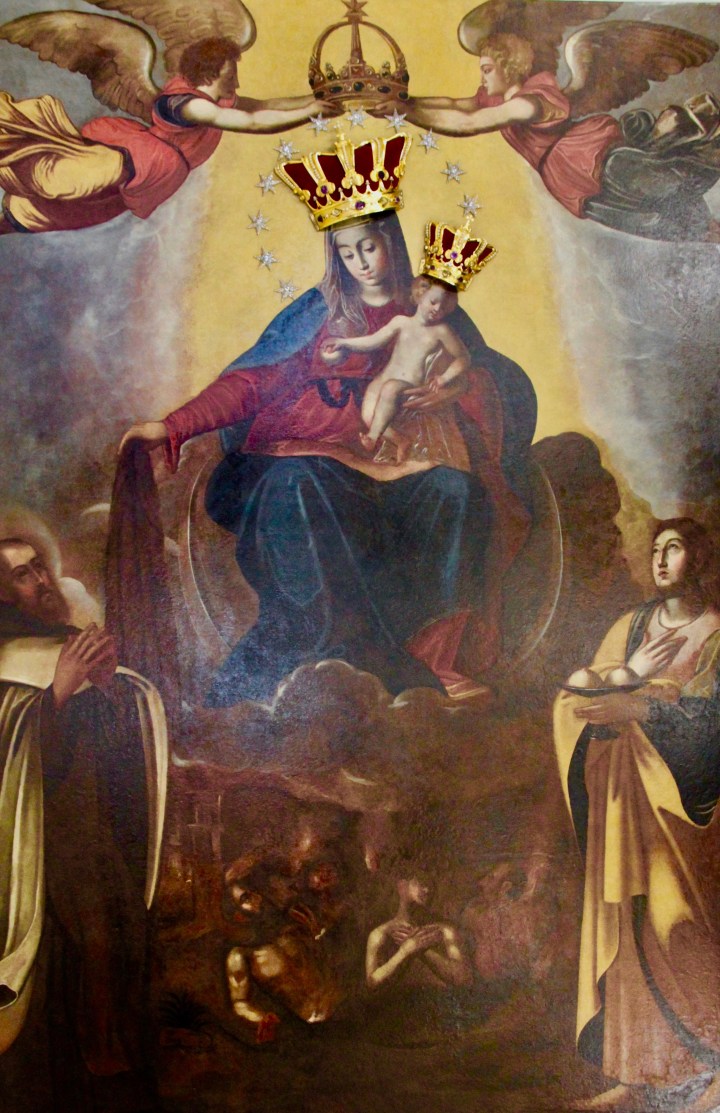
Fr. Victor Paul Farrugia O.Carm
Reasonably, the most prominent figure of the titular painting is that of the Virgin Mary. She sits on a royal throne and holds the Baby Jesus, whose nakedness emphasizes the humanity of Christ. Jesus expressing milk from his Mother’s breast is a unique feature of this image. The theological symbol is clear; Jesus wishes that we should receive graces through his mother, and this includes the relief of the souls in Purgatory. The expressed milk trickles down to refresh the souls in Purgatory, a reference to the commitment of Our Lady to help those souls, as referred to by the Sabbatine Bull.
However, Mary is separated from the souls in Purgatory by a cloud, which means that the painting was painted after 1613, in which year the Inquisition had decreed that Mary should not be depicted in Purgatory, but on a cloud above it.
Our Lady of Graces Sanctuary in Żabbar
The devotion in the Maltese Islands to Our Lady of Graces is many centuries old. Żabbar became a parish in 1616. The titular painting of the parish church is by the remarkable Maltese artist Alessio Erardi (1669–1727).
In this painting, Our Lady is holding Child Jesus, who is blessing the souls in Purgatory and releasing the slaves by means of an angel who is removing their chains. The Blessed Virgin is relieving the souls in Purgatory with her milk. The figure of St. John the Baptist, who accompanies Our Lady of Grace in the iconography, is represented by means of a ship from the Order of St John on her right and St. Bernard on her left, the saint who carries the name of the benefactor who commissioned the painting, Bernard Piscopo Macedonia, as can be seen by his family’s crest on the bottom left part of the painting. In 1951, the Madonna in the painting was crowned by Archbishop Michael Gonzi.
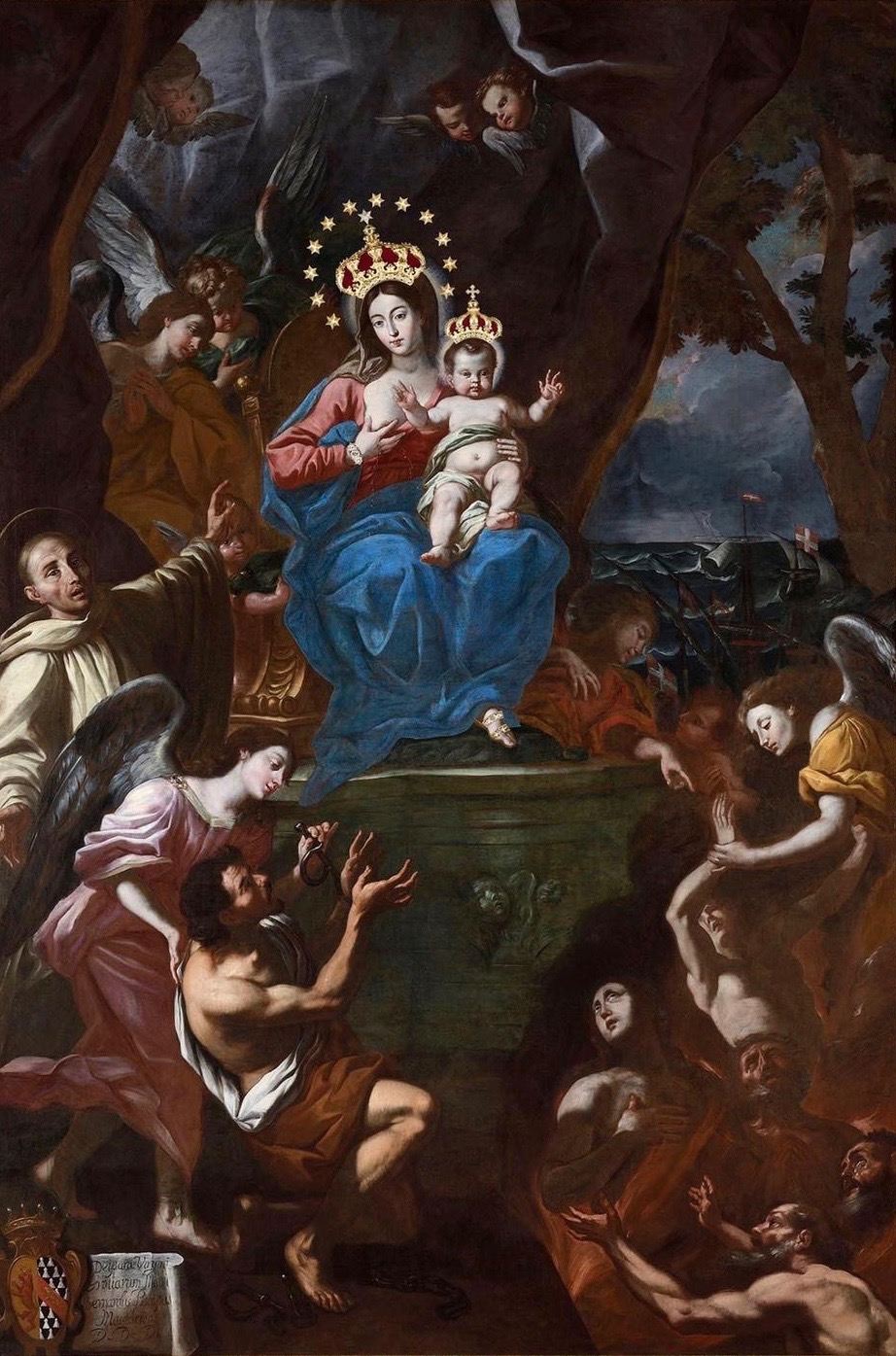
Our Lady of Grace Parish Museum, Żabbar
An unconfirmed theory states that the slave, who is the most detailed figure after the Madonna, might be a portrait of the artist himself, as there is a strong resemblance to the father of the painter, Stefano Erardi, who had done several self-portraits.
The Sanctuary has its own museum, with exhibits tracing the history of the locality from the Paleo-Christian Era down to modern times. An interesting item displayed is an early 16th-century fresco discovered in 1954 in a rural chapel dedicated to Santa Domenica. This is the oldest known image of Our Lady of the Graces in the locality, a clear proof of the deep-rooted devotion that the inhabitants of Żabbar have always had for Her.
The museum boasts of a unique ex voto collection of 87 votive paintings, amongst them the oldest being of 1631. The collection possesses the largest number of votive paintings, donated by the Fleet of the Order of Saint John. The most recent maritime ex voto was donated by Carmen Axiaq on September 21, 2012.
Our Lady of Mount Carmel in Saint Mary’s Parish, Gudja
Pietro Gagliardi (1809-1890) was one of the most skilled Italian artists to have executed work commissioned for Maltese patrons in the late 19th century. One of his finest paintings, Our Lady of Mount Carmel, is found in Gudja parish church of Saint Mary (The Assumption). The altarpiece is a Gagliardi too, logically depicting the Assumption.
Gagliardi worked in many of Rome’s finest churches, including San Rocco, San Vito and Saint Ignatius. By the 1870s, Gagliardi’s fame had spread to Malta where an increasing number of Italian artists were receiving commissions for newly created parishes. Gagliardi was soon to execute many paintings in Maltese churches as well as devotional paintings for the cathedral at Mdina.
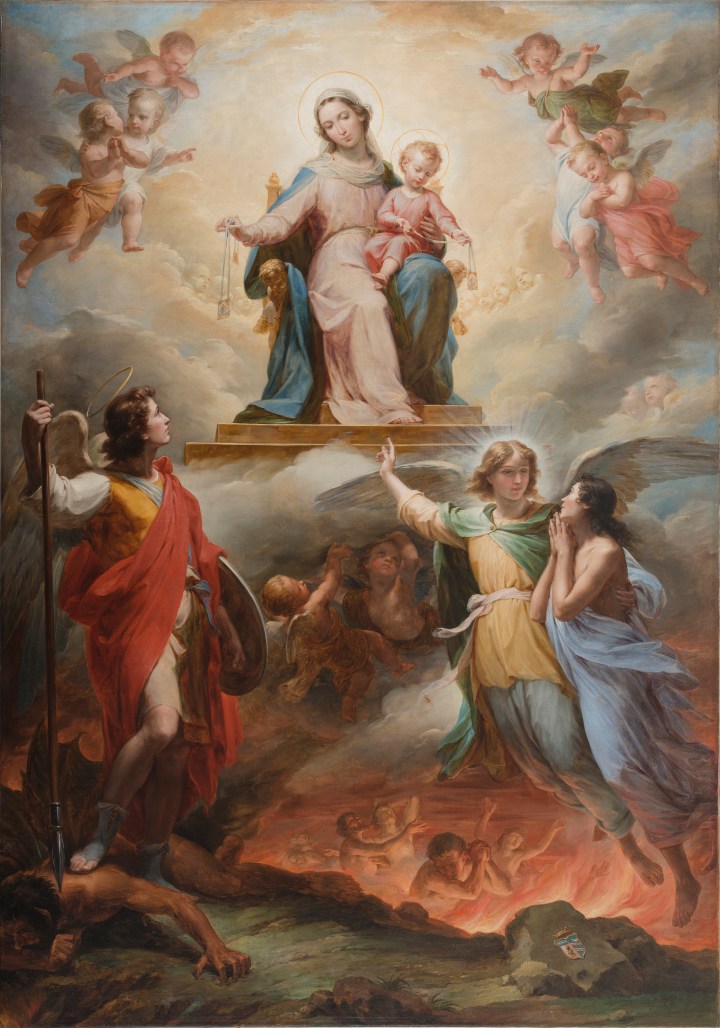
Gudja | Photo by Manuel Ċiantar and Suzanne Ciantar Ferrito
on behalf of ‘Amy Sciberras Conservators – Fine Arts Restoration.’
The Our Lady of Mount Carmel shows Our Lady seated on a throne with the infant Jesus on her lap. Both Virgin and child each hold a scapular. The throne floats in the heavens, and below the Virgin are a maelstrom of souls in purgatory whose infernal anguish is palpable.
In the foreground are the Archangels Michael (left) and Gabriel (right). Michael, whose name translates as “Who is like God?,” stands with his right foot placed on the prostrate Satan and turns towards Our Lady. Archangel Gabriel (“strength of God”) appears to be guiding the faithful from a fiery Purgatory up to the peaceful heavens. Gabriel’s right hand, pointing towards Our Lady, implies the intercession of the Virgin. The artistic composition is symbolizing the protection from evil (Satan) offered by Jesus, through Our Lady’s motherly protection and the scapular.
The Virgin of Mercy with Souls in Purgatory, Saint George’s Basilica, Gozo
Paintings of Mattia Preti (1613-99 – born in Taverna, Italy), the renowned baroque Calabrian master, are scattered all over Malta and Gozo, in churches, museums and other public places, as well as in private homes.
Mattia Preti’s fame reached a new height in 1650 when he was registered within the exalted annals of the Virtuosi del Patheon. He was in Malta for some 30 years, during which time he was admitted to the Order. In 1641 he was granted a knighthood by the Barbarini Pope Urban VIII, which earned him the nickname “Il Cavaliere Calabrese.”
In St George’s Basilica, Victoria (Gozo), one finds his two most renowned paintings in Gozo — the titular painting of the Collegiate Basilica of St George, which shows the saint standing on a decapitated dragon with his white horse on his side; and that of Our Lady of Holy Souls or The Virgin of Mercy with Souls in Purgatory, painted in 1688.
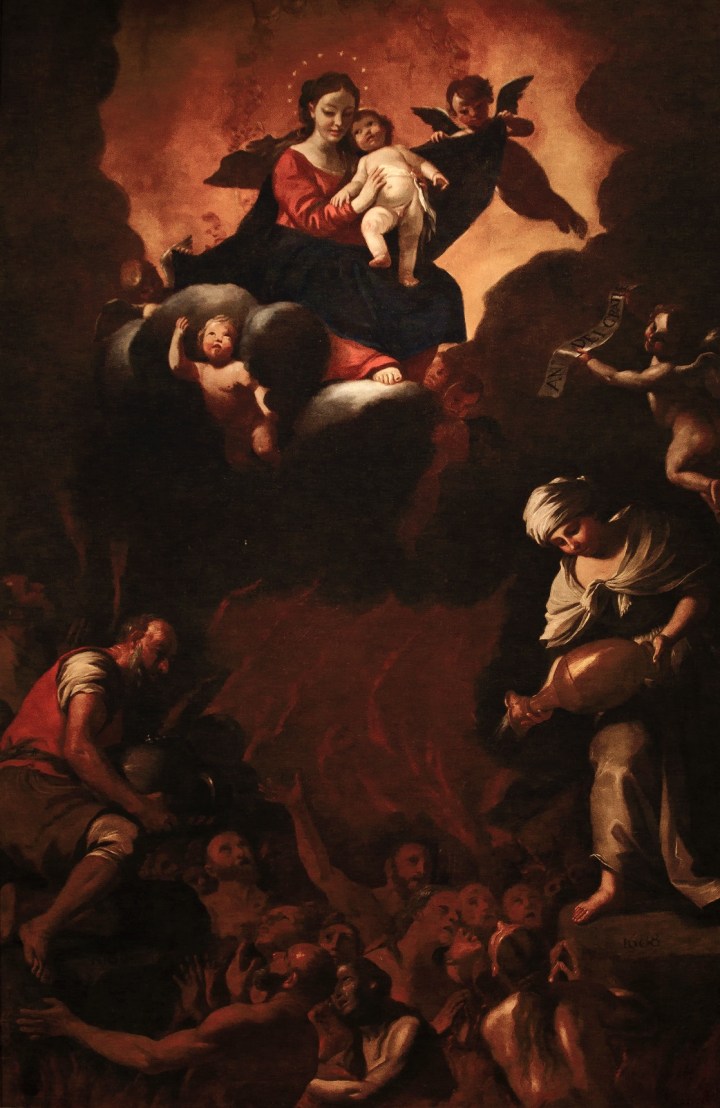
Saint George’s Basilica | Courtesy of Saint George’s Basilica. Photo by Joe Attard
This painting is housed in a transept, also dedicated to the Holy Souls in Purgatory, adorned with a beautiful altar dedicated to the Holy Souls. The huge painting on canvas represents Our Lady of Graces with the souls in Purgatory. The donors of the painting are seen on both sides pouring water to alleviate the souls’ suffering. There is a painting with the same theme in the museum next to the basilica.
Madonna Tal-Ħerba
In the heart of the ancient village of Birkirkara, there is a small church dedicated to the Virgin Mary. It was originally built in the midst of rocks, rubble, and ruins; and in time, it acquired the name of MadonnaTal-Ħerba.
We have no proven date when the original Sanctuary was erected, but from Mgr. Pietro Dusina’s pastoral visit, it transpires that in 1575 it was already a very well-known Marian shrine, enjoying great devotion. At first this church was practically unknown, but the Virgin Mary chose it as her own, from among many other majestic and more beautiful churches.
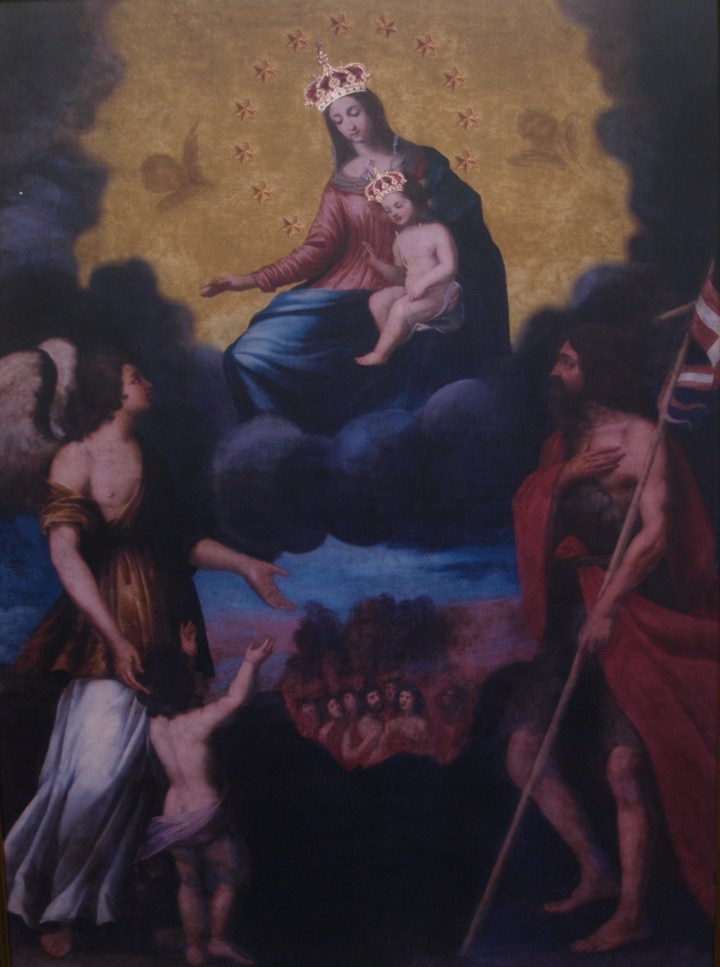
A river of graces showered the devoted Christians who prayed to the Blessed Virgin Mary before her beloved and fervently venerated altarpiece. Witness to all this are scores of ex voto paintings by numerous supplicants whose pleas were heard by the Blessed Virgin. Such votive paintings (in Marian sanctuaries across the Islands) also show the closeness between Our Lady and souls in Purgatory since souls often appear in the company of the Madonna (see feature photo – top).
The miraculous altarpiece depicts the Madonna holding the Child Jesus in her left hand, while her open right hand is welcoming souls the Guardian Angel releases from purgatory, while on the other side there is St. John the Baptist. The Madonna and Child were crowned on the August 7, 1910. Probably, this titular image was painted between 1668-1679, however, it is not the first one of the sanctuaries. In fact, it is a facsimile of a much smaller and older painting. However, the older one had the image of the Patriarch St. Joseph instead of the Guardian Angel. The old painting is now in the side chapel of the Sanctuary. It was underwritten by Chev. De St. Pierre, who is depicted praying to the Madonna, which is probably a gesture of thanksgiving for a grace granted to him by Holy Mary.
The Church of All Souls, Valletta
The Church of All Souls in Valletta was originally the church of San Nicola di Bari (Saint Nicholas of Bari), established in Valletta in 1569, immediately after the construction of the New City of Valletta (after the Great Siege of 1565).
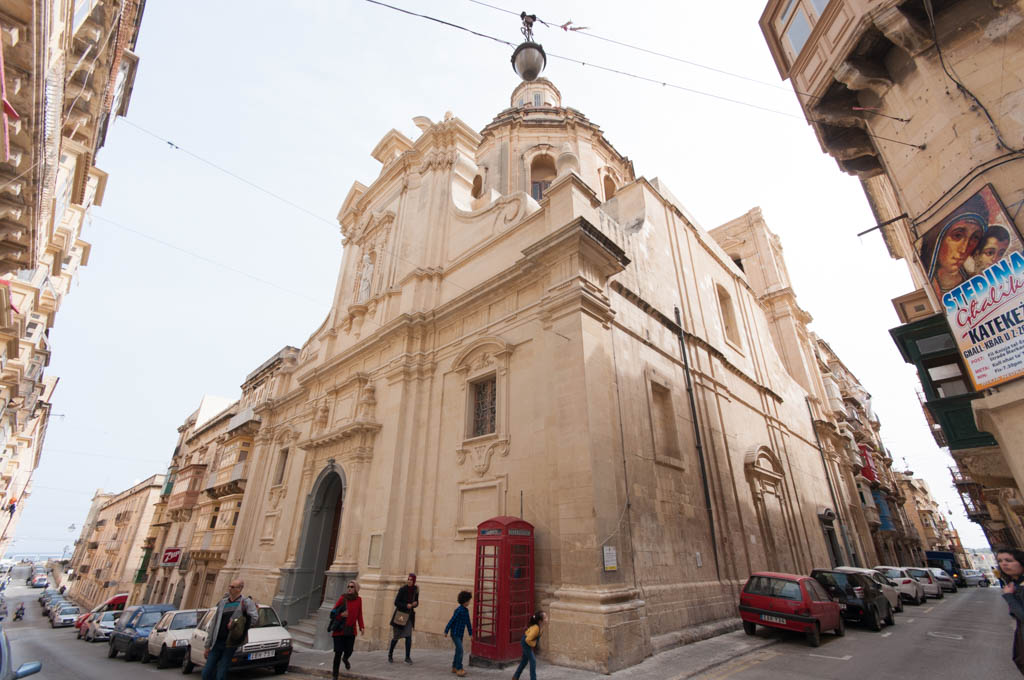
The church of St. Nicholas was originally a Greek Catholic Church, and it was under the jurisdiction of the Papas. In 1639, the parish priest Papas Giovanni Metaxi decided to separate from the Orthodox church and join the Greek Catholic Church, and he conceded the church of St, Nicholas to the Confraternity of the Souls in Purgatory, known as La Sodalita delle Anime Purganti. The Confraternity rebuilt the church in the Baroque style in 1652. So, it also became known as ‘Tal-Erwieħ’ (Maltese for “of All Souls”). However, today the church is referred to as both St. Nicolas’s as well as the Church of All Souls in Purgatory. It houses many paintings and sculptural works of art. The church was passed back to the Greek Catholic congregation in 2014; however, it is used for Roman Catholic and Serbian Orthodox services. Relations between the parish and the Confraternity are regulated by a concordat signed on September 17, 1766.The church suffered considerable damage due to aerial bombardment during World War II, but was repaired by 1951, including a complete reconstruction of the façade. Today, the church is a Grade 1 national monument, and it is also listed on the National Inventory of the Cultural Property of the Maltese Islands.
Final thought
Evidently, Our Heavenly Mother pours out her Immaculate Heart on suffering souls, and the message conveyed is very clear: She wants us to imitate her!
We have to ponder and act on what my dear Franciscan friend, Fr. Mario Attard, asks, “Am I in a closer communion with the suffering souls in Purgatory by offering Masses for their definite liberation from it?”
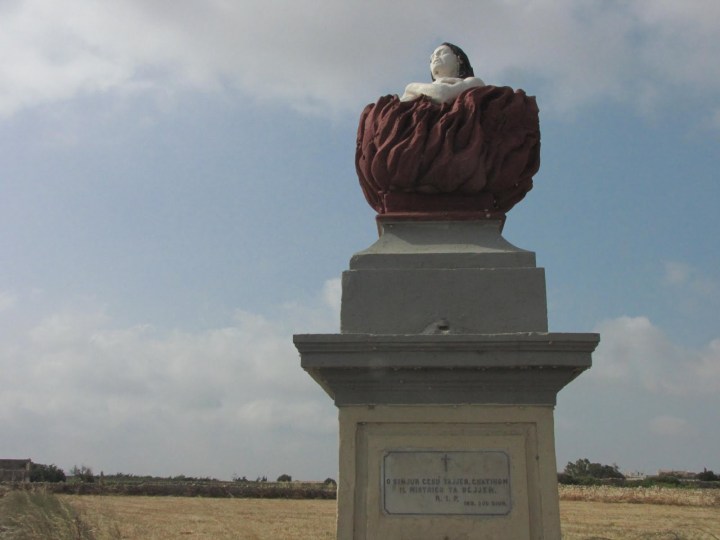
Images to remind us to pray for souls in Purgatory are everywhere in the Maltese archipelago. This one is in the open country between Rabat and Siġġiewi. The inscription in Maltese on the marble plaque is an intercessory prayer, saying, “O Good Lord Jesus, grant them eternal rest – R.I.P.” | globtr
References
Attard M. (OFM Cap.). Souls in purgatory. The Malta Independent, November 18, 2012
Murphy R. Our Lady and Souls In Purgatory. November 13, 2019. The Tablet
Spiteri, M. (2010). The church of All Souls (Tal-Erwieħ), Valletta : history, architecture and works of art (Bachelor’s dissertation)
Reassessing Pietro Gagliardi’s Our Lady of Mount Carmel. Times of Malta. May 1 2022
The Gozitan legacy of Mattia Preti. Times of Malta. June 19, 2013
Mattia Preti’s Connection with Gozo. Il-Hagar – Heart of Gozo
